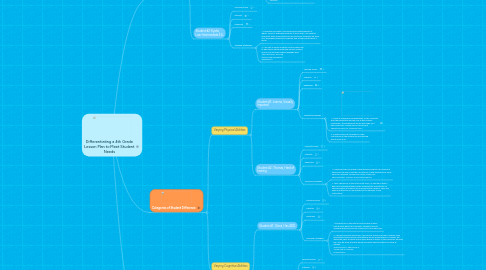
1. Varying Levels of English Proficency
1.1. Student #1: Bashir, Intermediate-Advanced ELL.
1.1.1. Learning Profile
1.1.2. Interests
1.1.3. Readiness
1.1.4. Teaching Strategies
1.1.4.1. 1. Have students work in groups to answer questions related to the Unit material. Questions will be in the format of a game. As students answer correctly they gain points. TECHNOLOGY: COMPUTER GAME ACTIVITY
1.1.4.2. 2. Students work in groups and play a board game like chutes and ladders. In order to roll the dice, students need to answer the question they draw correctly.
1.2. Student #2: Kyoko, Low-Intermediate ELL
1.2.1. Learning Profile
1.2.2. Interests
1.2.3. Readiness
1.2.4. Teaching Strategies
1.2.4.1. 1. Purposeful Grouping. I will group Kyoko with students at higher levels of English proficiency to work with. I will support and assist them during class time as necessary. Students will work on a worksheet assignment together and answer questions as a group
1.2.4.2. 2. I will use an online program such as Rewordify to help Kyoko better grasp the subject material and to fine-tune her English language skills. TECHNOLOGY: ONLINE COMPUTER PROGRAM- REWORDIFY
2. Learning Objective
3. Categories of Student Difference
3.1. Varying Physical Abilities
3.1.1. Student #1: Joanna, Visually Impaired
3.1.1.1. Learning Profile
3.1.1.2. Interests
3.1.1.3. Readiness
3.1.1.4. Teaching Strategies
3.1.1.4.1. 1. Create a Powperpoint presentation on the computer with the information and go over it with Joanna individually. The powerpoint will be with large font. TECHNOLOGY: LARGE FONT COMPUTER PRESENTATION OF INFORMATION.
3.1.1.4.2. 2. Create and sing a song that includes information on the material we are learning about in the Unit.
3.1.2. Student #2: Thomas, Hard of hearing
3.1.2.1. Learning Profile
3.1.2.2. Interests
3.1.2.3. Readiness
3.1.2.4. Teaching Strategies
3.1.2.4.1. 1. Create an audio recording of the lessons and give it to Thomas at the end of the day so that he can listen to it with earphones as many times as necessary, he can play it back, pause, etc. TECHNOLOGY: DIGITAL AUDIO RECORDING
3.1.2.4.2. 2. Have Thomas sit at the front of the room, so that he is able to hear most everything and provide a Powerpoint presentation of the information to support any oral information given in class. Will write all instruction on the white board in addition to oral instructions.
3.2. Varying Cognitive Abilities
3.2.1. Student #1: Gloria, Has ADD.
3.2.1.1. Learning Profile
3.2.1.2. Interests
3.2.1.3. Readiness
3.2.1.4. Teaching Strategies
3.2.1.4.1. 1. Students go on the play ground and play a game that requires physical movement. Students need to answer questions correctly as they run to the other side.
3.2.1.4.2. 2. Flipped Classroom Approach. I will provide students a Khan Academy type educational video based on the material we are learning about. Students will watch the video at home and do small group activities in the classroom the next day. This will allow Gloria to pause and replay the information as much as needed. TECHNOLOGY: CREATING A VIDEO FOR A FLIPPED CLASSROOM.
3.2.2. Student #2: Vincent, Has Dyslexia
3.2.2.1. Learning Profile
3.2.2.2. Interests
3.2.2.3. Readiness
3.2.2.4. Teaching Strategies
3.2.2.4.1. 1. Students work in groups and create a theatrical play that outlines one cultures traditions, background, and other unique elements.
3.2.2.4.2. 2. Have students pick and draw a picture of a culture and its unique elements using a computer program like Microsoft Paint or Inkscape. Students will then orally present their computer drawings to the class while describing the cultural elements that drew. TECHNOLOGY: COMPUTER ART PROGRAM
